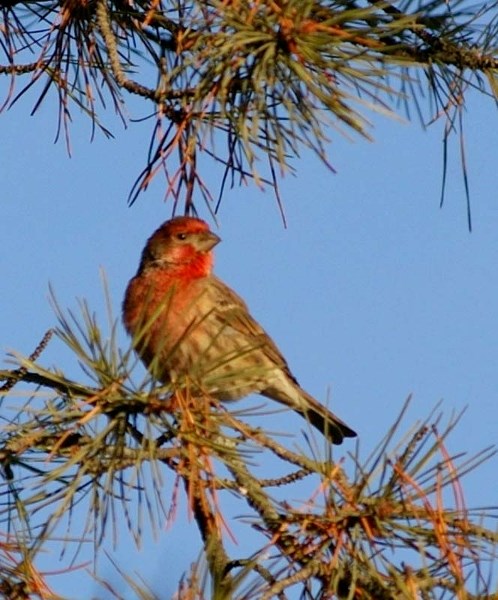Dan Stoker knew something was up when he heard a cheery little songbird warbling away in the dead of winter back in December 2006. Stoker was out with fellow birder Dave Nadeau taking part in the Christmas Bird Count.
Dan Stoker knew something was up when he heard a cheery little songbird warbling away in the dead of winter back in December 2006.
Stoker was out with fellow birder Dave Nadeau taking part in the Christmas Bird Count. The song was strange, he said, as there were few birds that bothered to sing at all during December.
"I didn't know what I was hearing or seeing at first; just a very pleasant call in the middle of winter that seemed out of sorts."
Later, they spotted a bunch of red-bibbed, streaky brown birds sitting in a spruce in Lacombe Park twittering away, and realized they had discovered a new species in the city's bird count: the house finch.
House finches have exploded in number in St. Albert since then. A record 280 were spotted in the city last December, compared to just 11 back in 2006.
These birds showed up in Edmonton at around the same time as St. Albert, said Lu Carbyn of the Wildbird General Store. They're now very common, with about 1,067 of them spotted in the most recent Christmas count.
House finches resemble sparrows that have just been in a pie or jam-eating contest.
"They look like they've been dipped in strawberry juice," Stoker said.
They've got the big beaks and streaky-brown wings of house sparrows, but have a messy red bib on their chest and more red on their face. Male house sparrows have a black bib. Redpolls have a small patch or cap of red on their head and more of a pale red vest.
It's very tough to tell a house finch apart from a purple finch, Stoker said – he initially mistook the former for the latter back in 2006.
Carbyn said house finches have more dark streaks on their sides than purple finches. They also have a very square tail, compared to more pronounced notch in the tail of the purple finch.
Females are a little easier, Stoker said. Female purple finches will have a white patch or stripe over their eyes; female house finches won't.
As purple finches are very rare in this region during the winter (just 12 have shown up in the history of the St. Albert Christmas count), odds are good that any finches you see wearing a red bib at this time are house finches, Carbyn said.
New York invasion
The house finch is an introduced species originally found in southern California and Mexico, said Dick Cannings, who co-ordinates Canada's Christmas bird count for Bird Studies Canada. The birds started spreading up the west coast in the 1900s and reached B.C. in 1935, where they are now well established.
But Alberta's house finches actually came here from New York, he continued. Back in the 1940s, many were sold as pets there because they were colourful and sang a bunch. This was illegal, so shop owners dumped the birds en-masse, creating a new wild population there.
Researchers suspect the birds reached a critical mass in the 1980s that let them spread west across Canada, Cannings said. (The birds don't migrate, which meant they were unlikely to cross over from B.C. on their own.)
Now, they show up at backyard feeders such as the one at Stoker's home on a regular basis.
"Practically every day I will have a small flock of 10 to 15 come by," he said.
"Certainly in Lacombe Park, they're very common."
House finches are colourful, gregarious birds that bring a little cheer to your bird feeder, Carbyn said.
"They're very voracious feeders," he said, so you can expect them to camp out around a few backyards all winter long – hence the "house" in "house finch."
Bye-bye sparrow?
There's some evidence that the house finch may be displacing the house sparrow. St. Albert Christmas bird count data suggests a very slight decline in house sparrow numbers since 2006 compared to a near exponential rise in house finches over that same time.
An April 2007 study in Ecology of house finches in the north-eastern U.S. found a noticeable drop in house sparrow numbers following the arrival of house finches. It also found that the sparrow numbers bounced back in the mid-1990s after a disease devastated finch populations, and that the two populations seemed inversely related. It concluded that the two species were likely in competition with each other.
Any birdfeeder with sunflower seeds is bound to attract house finches, Stoker said. You'll otherwise find them in tall spruce trees, typically in flocks.
Keep your ears open for their cheery little tune as well, Stoker said. "These guys just seem to enjoy sharing a tune in the middle of winter."
House finch
Name:
Haemorhous mexicanus.
Appearance:
Small finch with big beak, streaky brown back, rosy-red face and upper breast, with a red rump. Females are greyish-brown with thick, blurry streaks and no redness.
Commonly seen:
Camping out at your feeder, singing like it's spring.
Occasionally confused with:
Redpolls, which are just red on top; purple finches, which are nearly identical to them; house sparrows, which have black bibs.
Fun fact:
The redness of their chest is determined by the colour of their food, so you can get orange or yellow house finches. Female finches seem to prefer red males as it suggests they are better at finding food.
Wild St. Albert
Like wildlife? So do we! Every second Wednesday the Gazette profiles a reasonably common wild creature in the St. Albert region. Birds, beasts, bugs, fish … so long as it's alive and kicking, we'll feature it. Got a creature you'd like to see profiled? Send your suggestions to [email protected].




